| WAT MAE NANG PLUM (วัดแม่นางปลื้ม) |
| Wat Mae Nang Plum is situated off the city island in the northern area of Ayutthaya in Hua Ro sub-district. The monastery is located near the confluence of Khlong Hua Ro, Khlong Mueang, and the junction canal of the old eastern city moat, all being the river bed of old Lopburi River in the Ayutthaya era. Wat Phrao and Wat Mongkut were situated on its north side, while Wat Tha Khlong was on its west. The temple is still in use by the Buddhist clergy. Following the tamnan (1) history, this monastery is in existence since 1377. The name of this temple is mentioned in the Royal Chronicles of Ayutthaya related to a herd of elephants which showed up close to the monastery and were rounded up near Wat Song around end 1548, beginning 1549. [1] (2) The monastery bears the name of a certain Lady Plum, an old woman being visited by King Naresuan (r. 1590-1605) during one night, following a local legend. Van Vliet describes the event in an account from 1640 - "The short history of the Kings of Siam". [2] The story goes as follows: "One evening when His Majesty was on a perahu in the river, he was caught in a great rainstorm before he was able to return to the palace. Consequently, he went to a small house where an poor old woman lived and entered unrecognized with great commotion. The woman was very frightened and said, "My son, don't you know, that our King is often close by?" In reply His Majesty said vehemently, "Mother, and so what if he should hear it? What would it matter if he kills me. That would be my misfortune which strikes many people unexpectedly." The woman fell at his feet and pleaded dejectedly that he not speak of the king in such a way. She said, "The gods have provided us with His Majesty; therefore, he never does things which are bad. He is an avenger of the gods and the implementer of their sentences against our evil. We must obey those who have been placed here to rule us ". The more the woman tried to silence the king with such reasons, the more vehemently His Majesty bellowed. Finally, the woman asked that he leave her house because she did not want to become a party to his misdeeds. The king said that he would, but first demanded a drink of arak because he had become cold from the rain. The woman answered, "Son, you know of course that this is the fast and that as long as it lasts, no one may buy or drink arak. But if you want dry clothes such as those I am wearing, I will give them to you. I will wash and dry what you have on. In the meantime go rest and sleep a little." The king accepted the clothes offered to him, had his clothes washed and dried, but would not desist from his wish for arak. He said that he did want to be bound by the strict laws of the king. Finally, the woman filled a tiny little jug with arak. She swore that she had bought the arak before the start of the fast and had not drunk any of it since then. She offered it to the king and made him promise that he would not report her to anyone. After he had drunk, the woman led him to her little mat to sleep while she dried his washed clothes. When the king awoke, he put on his dried clothes, thanked the woman, and said his farewells. The woman said, "Son, remain here until daylight or go home with your boat quietly so that you do not make too much noise for the king and have something evil befall you." His Majesty answered, "I will do that," and left the old woman and her poor little house. He then returned with his little perahu to his bodyguards, who were waiting with their perahus not far from that little house. The next day His Majesty sent a royal ceremonial perahu (on which was a small pyramidal house) to the poor woman's simple little house where he had lodged at night. This was the same perahu and the same little house that carried the king's mother or first wife on great feast days. Besides this, the clothes which Their Majesties had worn were also on board. He instructed to servants that after presenting these clothes to the old woman, they were conduct her with the royal perahu to court and bring her before him. When the old woman saw the royal servants coming towards her, she became frightened and started trembling, thinking that His Majesty had heard what happened in her home that night. Although these servants reported why they had been sent, the woman could not believe that she would remain unharmed. Furthermore, out of fear she beseeched the servants in a pitiful manner to tell the king that she had died. Meanwhile she wanted to save her life by fleeing to the monks. The servants, however, paid no heed to the woman. Since she did not want to go willingly, they respectfully seized her, clothed her, brought her on the perahu to court, and then presented her to the king. When His Majesty saw the woman, he took her by the hand and told her that he was the person who had lodged and been cared for at her little house at night. "And because in time of need you accepted me for your son," said the king, "henceforth I will call you Mother and love you for this." His Majesty ordered a place for the old woman in the palace, and had her served and cared for till the end of her days as if she had been his own mother. At her death she was also cremated as a queen." [2] Following the tamnan history, this temple was repaired by King Naresuan and renamed as Wat Mae Nang Plum, in commemoration of the old lady. The monastery has the classical outfit of a vihara, ubosot, and chedi. The temple area has been cut in two by the road leading from the city to the elephant kraal. On the south side of the road are the monk's living quarters. In the ordination hall, a beautiful Buddha image called Phra Pho Khao or White Buddha can be seen. The chedi of this monastery is built in a particular style. The base is surrounded with decorative stucco lions, with exception of Wat Thammikarat and Wat Maheyong nowhere else seen in Ayutthaya. The decorative style was likely inspired by the northern Sukhothai style. Chedis with a base of decorative elephants are seen in Sukhothai (Wat Chang Lom), Sri Satchanalai (Wat Chang Lom) and Kamphaengphet (Wat Chang Rop). Some studies indicate that the idea of decorating the base of the chedi with lions on a couple of temples in Ayutthaya should be attributed to King Borommaracha II (r. 1424-1448) after having conquered Angkor in 1431. Following the Royal Chronicles of Ayutthaya, he brought images of lions and other creatures from Angkor, hence the inspiration. [3] The main bell-shaped stupa of Wat Mae Nang Plum at par with Wat Maheyong built in the reign of King Borommaracha II is estimated to be constructed in the Early Ayutthaya Period and based on the Sukhothai style. Wat Mae Nang Plum's stucco lions are different from the lions at Thammikarat. The Khmer Bayon-styled lions from Wat Thammikarat seems here to be more "Thai-styled", which could lead to the conclusion that the chedi at Wat Mae Nang Plum must have been built or remodeled later than the caitya at Wat Thammikarat. There was a boat ferry between the landing above the Maha Chai Fortress at the Hua Ro corner across to the landing of Wat Mae Nang Plum. This landing on the city island was also called Tha Khun Nang or the Noblemen Landing and was in fact the second official landing. In the Ayutthayan era, there were twenty-two ferry routes between the mainland and the city island. The northern side had seven ferries. The six other crossings were: Tha Nuea to Wat Khun Yuan, Tha Ma Ap Nam to Wat Choeng Tha, Tha Khan to Sala Trawen, Tha Sip Bia to Wat Pho, Wat Tha Sai to Wat Rong Khong, Wat Song to Wat Pa Khonthi. [4] See "The Boat & Ferry Landings of Ayutthaya". The monastery is indicated on Phraya Boran Rachathanin's map drafted in 1926 and figures also on a mid-19th century map. Wat Mae Nang Plum is located in geographical coordinates: 14° 22' 5.32" N, 100° 34' 9.30" E. Footnotes: (1) Tamnan is a term frequently used for documents dealing with the history of Buddhism or particular Buddhist monuments. It came into existence well before the 15th century and though it began to decline in the 17th century, its influence lasted until the 18th century. Tamnan histories begin at the point when the Gautama Buddha made a vow to reach enlightenment. [5] (2) It is clear that most of the Chronicles of Ayutthaya have been written after the fall of Ayutthaya. The monastery is following these chronicles already named Mae Nang Plum during usurper King Worawongsa's reign (r. 1548), but following the tamnan's history, this temple was only renamed Mae Nang Plum by King Naresuan (r. 1590-1605), somehow about sixty years later. The temple's original name remains unknown. About fifteen days later the officials in Lopburi sent down a report about a male elephant, [E: over] six sok [BCDF: and four niu] high, whose ears and tail all bore the marks of its belonging to a herd. The chief ministers informed the King who said, "We will go up to take it. In two days we will set out, so we order that an official command be sent up to have the [BCDF: officials] [E: Department of Elephants] go ahead and catch it." About seven days later a herd of elephants, breaking out of the cover of the jungle, came in toward Mae Nang Plum Monastery and entered a corral at Song Monastery. The chief ministers informed the King who said, "Tomorrow we will go to catch them." [6] References: [1] The Royal Chronicles of Ayutthaya - Richard D. Cushman - page 24 / Source: Phan Canthanumat, British Museum, Reverend Phonnarat, Phra Cakkraphatdiphong & Royal Autograph. [2] Van Vliet's Siam - Chris Baker, Dhiravat Na Pombejra, Alfons Van Der Kraan & David K. Wyatt (2005) - page 230/231. [3] The Royal Chronicles of Ayutthaya - Richard D. Cushman (2006) - page 15 / Source: Luang Prasoet, Phan Canthanumat, British Museum, Reverend Phonnarat & Royal Autograph. [4] Athibai Phaenthi Phra Nakhon Sri Ayutthaya kap khamwinitjai khong Phraya Boran Racha Thanin - Explanation of the map of the Capital of Ayutthaya with a ruling of Phraya Boran Rachathanin - Revised 2nd edition and Geography of the Ayutthaya Kingdom - Ton Chabab print office - Nonthaburi (2007) - page 92. [5] The Rise of Ayudhya - Charnvit Kasetsiri (1976). [6] The Royal Chronicles of Ayutthaya - Richard D. Cushman (2006) - page 24 / Source: Phan Canthanumat, British Museum, Reverend Phonnarat, Phra Cakkraphatdiphong & Royal Autograph - Nobles Plot to End Usurpation. |

| Text, maps & photographs by Tricky Vandenberg - September 2009. Updated December 2014 |
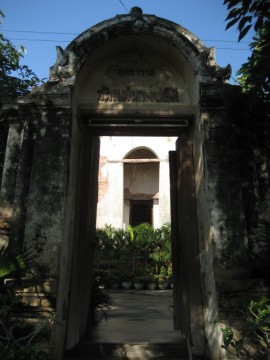
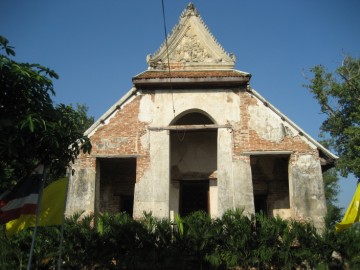
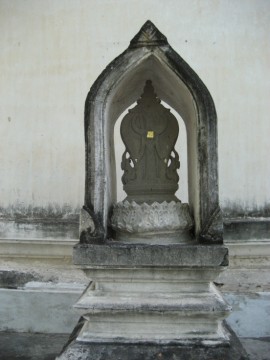
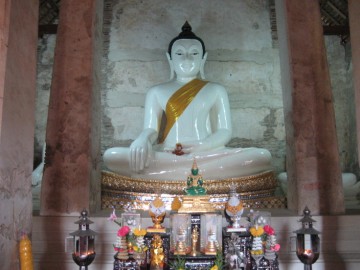
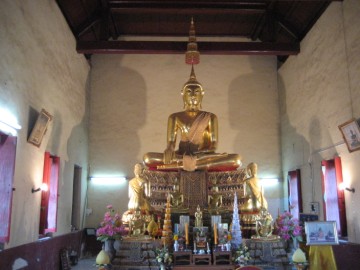
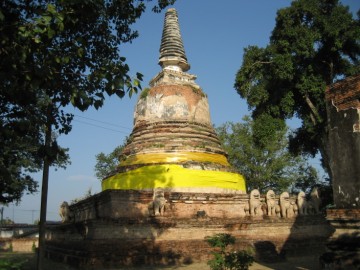
| (The ordination hall or ubosot) |
| (Entry through the outer wall) |
| (Boundary stone or bai sema) |
| (Main chedi with stucco lions) |
| (Luang Pho Khao in ubosot) |
| (Buddha image inside vihara) |
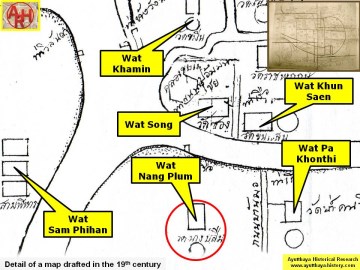
| (Detail of a 19th century map - Courtesy of the Sam Chao Phraya Museum) |
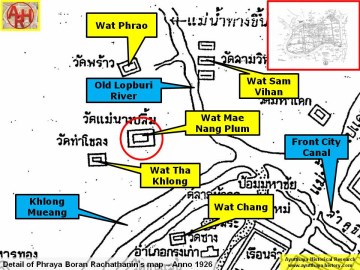
| (Detail of Phraya Boran Rachathanin's map - Anno 1926) |
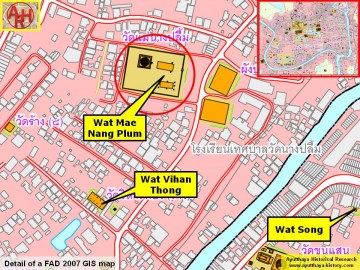
| (Detail of a 2007 Fine Arts Department GIS map - Courtesy of the Fine Arts Department - 3th Region) |


| (Wooden gable decoration with Vishnu (Th: Narayana) mounted on the mythical bird Garuda in Ayutthaya style dating back to the 17-18th century and originating from Wat Mae Nang Plum and kept at the Chao Sam Phraya National Museum. The triangle-shaped, engraved pediment was coated with lacquer, gilded and had glass-decoration. Vishnu has a crown on his head, symbolising his supreme authority. His left-hand holds an arrow, while his right hand unfortunately broken, held likely Sharanga, the celestial bow. Vishnu is surrounded by a group of giants carrying a club. Below, in both corners, we find the image of a demon with a Singha-face holding a Kris-like weapon and also the image of a bird.) |